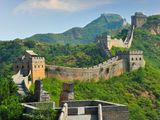Once Upon a Time Why They Improve the Wall Again and Again
The ane thing most people "know" about the Great Wall of Cathay—that it is one of the only man-fabricated structures visible from space—is not really truthful. Since the wall looks a lot like the rock and soil that surround information technology, it is hard to discern with the homo eye even from low Earth orbit, and is difficult to make out in almost orbital photos. However, this does not backbite from the wonder of this phenomenal ancient structure. For millennia, Chinese leaders instituted wall-edifice projects to protect the land from northern, nomadic invaders. One surviving department of such an ancient wall, in the Shandong province, is made of difficult-packed soil chosen "rammed earth" and is estimated to be 2,500 years quondam. For centuries during the Warring States Menstruation, earlier China was unified into one nation, such walls defended the borders. Around 220 B.C.E., Qin Shi Huang, also called the Offset Emperor, united China. He masterminded the process of uniting the existing walls into i. At that time, rammed earth and woods fabricated upwards near of the wall. Emperor after emperor strengthened and extended the wall, often with the aim of keeping out the northern invaders. In some places, the wall was synthetic of brick. Elsewhere, quarried granite or even marble blocks were used. The wall was continuously brought up to date equally building techniques advanced. Zhu Yuanzhang, who became the Hongwu Emperor, took power in 1368 C.E. He founded the Ming Dynasty, famous for its achievements in the arts of ceramics and painting. The Ming emperors improved the wall with watchtowers and platforms. Virtually of the familiar images of the wall show Ming-era construction in the rock. Depending on how the wall is measured, information technology stretches somewhere between 4,000 and v,500 kilometers (two,500 and 3,400 miles). In the 17th century, the Manchu emperors extended Chinese rule into Inner Mongolia, making the wall less important as a defence force. However, information technology has retained its importance every bit a symbol of Chinese identity and culture. Countless visitors view the wall every twelvemonth. It may not be clearly visible from space, only it is considered "an absolute masterpiece" here on Earth.

The Not bad Wall of Cathay is one of the most notorious structures in the entire world. The Jinshanling section in Hebei Province, China, pictured here, is merely a pocket-size office of the wall that stretches over four,000 kilometers (2,500 miles).
Photo by Hung Chung Chih
ceramic
Adjective
made of clay.
Substantive
learned behavior of people, including their languages, conventionalities systems, social structures, institutions, and fabric goods.
dynasty
Substantive
series of rulers from one family unit or group.
emperor
Noun
ruler of an empire.
millennium
Noun
k years.
nomadic
Adjective
having to do with a way of life lacking permanent settlement.
orbital photo
Noun
photo taken from Globe orbit, above the atmosphere
rammed world
Noun
mixture of soil, clay, and rocks packed together as building fabric.
Source: https://www.nationalgeographic.org/encyclopedia/great-wall-china/
0 Response to "Once Upon a Time Why They Improve the Wall Again and Again"
Post a Comment